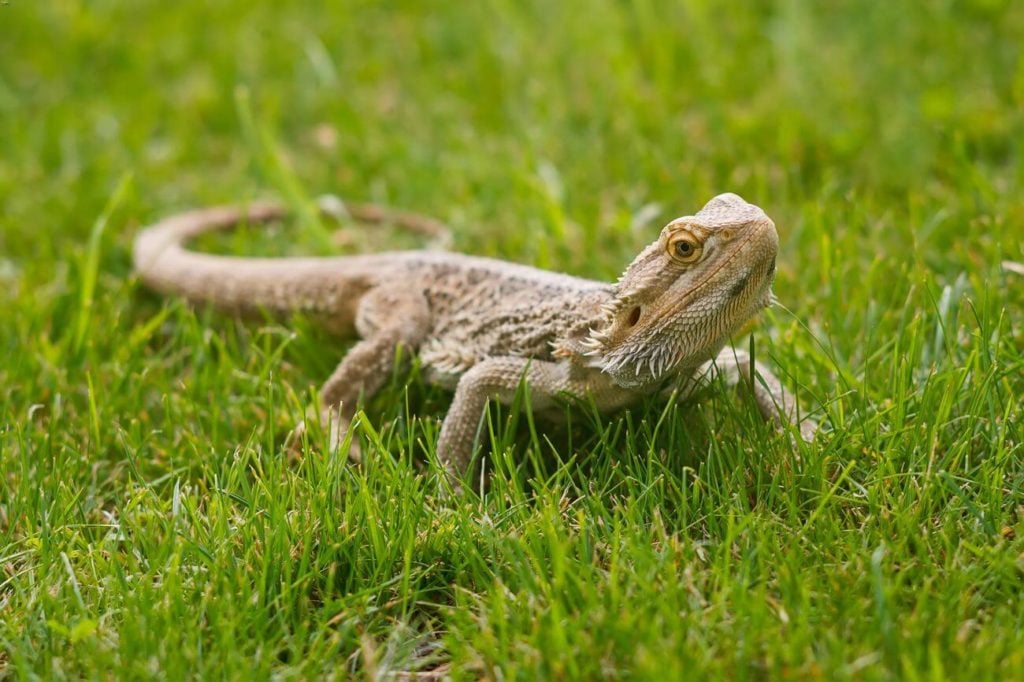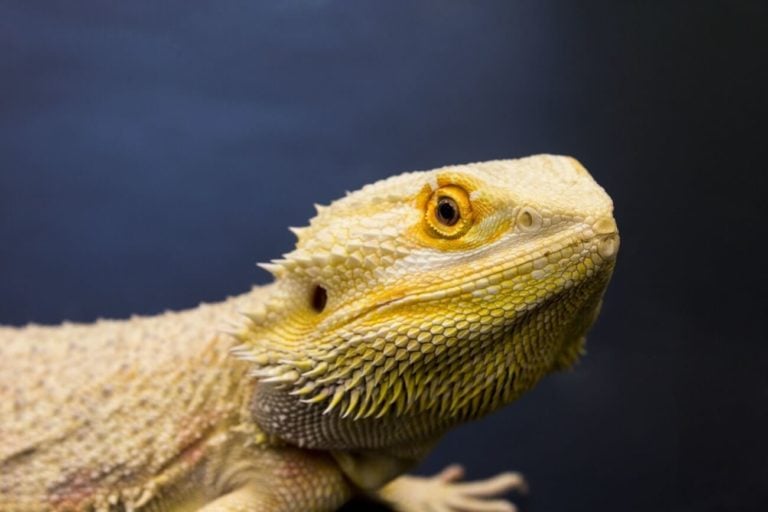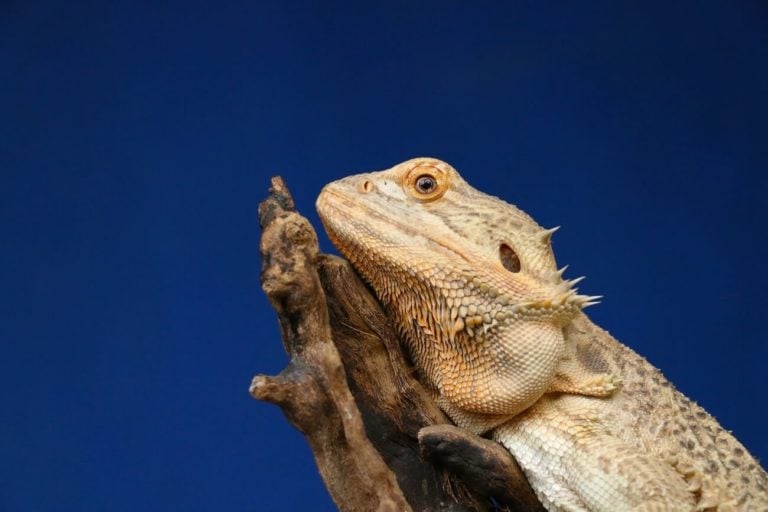There are a number of options out there, but all the best bearded dragon substrates have a few things in common.
They’re safe, low-maintenance, and affordable.
In this guide we’ll help you pick the best substrate for your beardie, and avoid materials that could cause them harm.
Let’s get started!
Table of Contents
Why Choosing The Right Substrate Is Important
Beyond the enclosure itself, choosing the right bearded dragon substrate is one of the most important decisions you’ll make! In case you’re unaware, the substrate acts as the flooring for your beardie’s enclosure.
Ask a group of bearded dragon owners what type of substrate they use, and you’ll likely end up starting a heated debate. Substrate materials are a big point of contention in the beardie world.
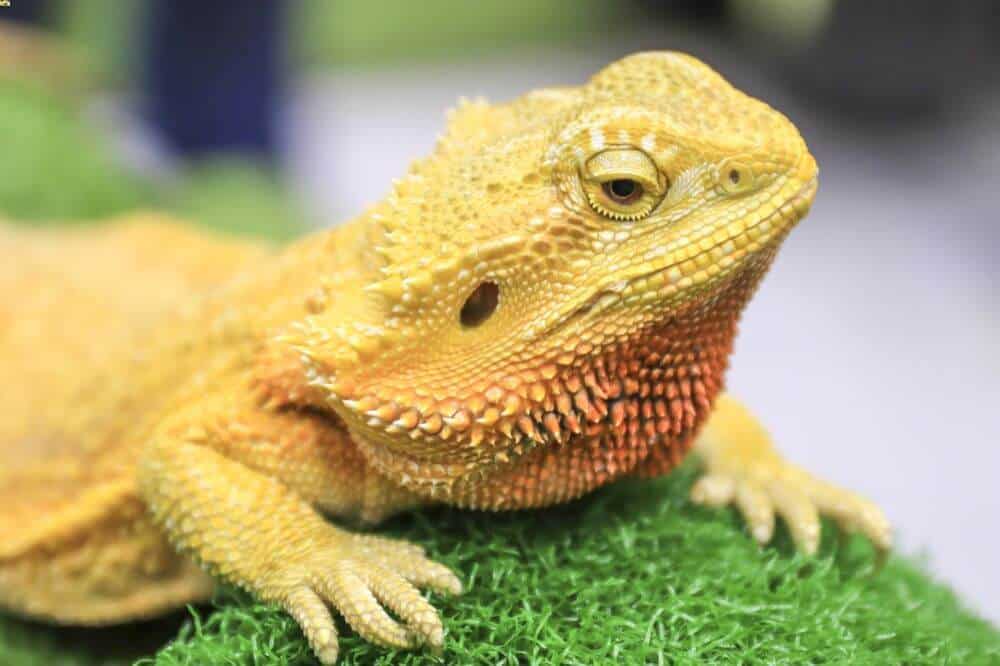
Unfortunately, there’s a lot of misinformation about suitable substrates floating around out.
Pet stores aren’t helping the cause, either! When you’re shopping for a substrate, you’ll come across several different options. Many of them aren’t suitable for bearded dragons.
It might not seem like a huge deal, but the quality of the substrate is going to have a massive impact on your beardie’s health and quality of life (as well as their lifespan). Your reptile is going to spend their entire life on the material! It’s not a decision you should take lightly.
The goal is to pick a material that’s comfortable, safe, and easy to maintain. If the substrate doesn’t check off those boxes, you run the risk of creating a dangerous and unhygienic environment for your bearded dragon.
At the end of the day, keeping your reptile safe and healthy is the top priority. The right bearded dragon substrate will help you do just that!
The Best Bearded Dragon Substrates
Don’t be fooled by clever marketing or product labels at the pet store. You have to do your part to understand what works and what doesn’t.
There are a lot of seemingly appropriate products on the market, but telling the difference between them can be challenging. Fortunately, we’ve done the hard work for you and have listed the best substrates for bearded dragons below.
1. Reptile Carpet
Generally, herpetology enthusiasts separate substrates into two distinct categories: loose-particle substrates and non-particle substrates. Carpet reptile falls into the latter category.
The biggest issue with loose-particle substrates is the risk of ingestion. Beardies aren’t the cleanest eaters around. This is especially true with juveniles.
- Can’t be accidentally ingested
- Easy to clean and wash
- Natural green color
- Absorbent and non-abrasive
When a beardie eats insects (like crickets) or other foods off a loose-particle substrate, they will often consume a bit of it in the process. Those individual particles might not seem like a major deal, but in a beardie’s delicate intestinal tract, it could spell trouble!
Impaction is a very real problem among bearded dragons living in a loose-particle substrate. The individual pieces get stuck in the digestive system. It’s a potentially life-threatening problem that you must avoid at all costs.
With a reptile carpet, you don’t have to worry about impaction issues at all! Like the carpet in your own home, reptile carpet is a solid piece of woven material. You can cut it to fit the exact shape of your lizard’s enclosure.
Carpet is available in a range of colors and finishes. But most mimic the natural appearance of grass or sand. It’s a comfortable substrate that feels good underfoot for your beardie.
You can run into some potential problems with low-quality carpets. The individual fibers can get loose, which snags your lizard’s claws. Those issues can be dangerous, too. However, they are easily avoidable.
Stick to high-quality carpets that have tightly woven fibers. Never use carpets or rugs made for humans. It’s crucial to keep an eye on the quality of the material, too. If you notice any fuzziness to the material at all, use a lint shaver to get rid of it or swap out your carpet for a new one.
Expert Tip: It’s also important to stay on top of maintenance. Cleaning a reptile carpet is a more involved process. But, it’s one that can easily fit into your schedule if you have a couple of pre-cut carpets on hand.
Some avoid carpets because of their reputation for holding onto smells. While this is true to some extent, it all comes down to how you maintain it! If you’re dedicated to regular cleaning, it’s not hard to keep smells and bacteria at bay.
Overall, reptile carpet is one of the best bearded dragon substrates available. Ignore the naysayers and give it a shot! You’ll be surprised at how efficient and safe it is.
2. Tile
Believe it or not, the same types of tile you use in your kitchen sink are one of the best substrates for bearded dragons.
Many seasoned owners have been using tiles for years. However, it’s only recently becoming more widespread in the beardie community.
When you look at the benefits tile has to offer, it’s not hard to see why.
Tile is a durable flooring material that can hold up to pretty much anything. Wet and dry messes are no problem at all. You can easily wipe down the tile or wash it in the sink!
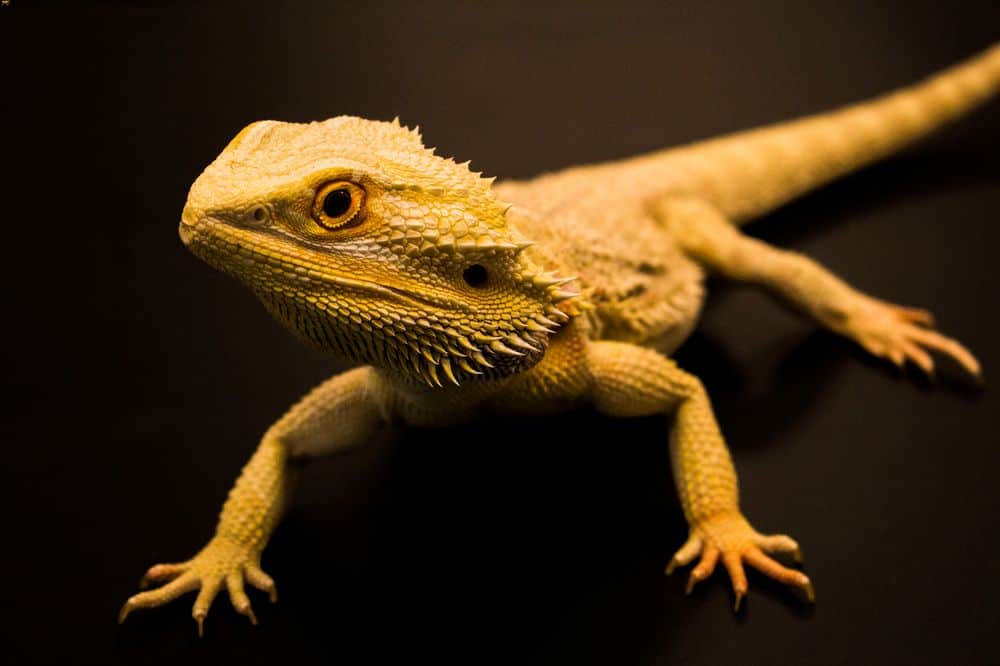
Plus, it’s completely safe. There are no loose particles for your lizard to ingest. Tile doesn’t even retain moisture. Unlike reptile carpet and other absorbent substrates, there’s no concern about stains or smells.
Ultimately, the biggest perk of tile is how low-maintenance it is. It’s a permanent substrate material that you never have to replace, too.
Beyond that, tile has a couple of unique benefits as a substrate for bearded dragons:
For one, it can absorb heat and provide a bit of additional comfort for your lizard. This isn’t true with all tiles. But most can hold onto residual heat from the basking light. That way, your pet can still enjoy the warmth even after the lights go out.
Some tiles can also keep the claws trim and neat. If you hate having to groom your bearded dragon’s nails, tiles will take care of that issue. Walking and running on the tile gradually wears the nails down. Think of it as a natural nail file!
You might see some bearded dragon owners commenting on the slippery nature of tiles. It’s true that some tiles provide less traction for your lizard, which can result in slipping. But like anything else, it comes down to the type of tile you use.
There are plenty of textured tile products out there. Just take a walk through your local home improvement store! You can even glue a bit of sand to the surface of the tile to create a gritty texture.
The best types of tile to use as bearded dragon substrate are ceramic, slate, and linoleum. Do not use glass or metal. You want to avoid anything that reflects heat and light, as they could turn your beardie’s habitat into an oven. Instead, stick to materials that absorb heat.
Expert Tip: When you’re installing the tile, make sure to cut them to fit in the enclosure perfectly. It’s also a good idea to use some silicone caulking to seal up any gaps that could injure your pet.
3. Newspaper
Looking to save a bit of money and time? A newspaper substrate might be the solution you’re after!
Newspapers, paper towels, and other discarded paper products work quite well for bearded dragon enclosures! It’s not the most glamorous substrate option in the world, but the benefits of the material make it a worthy consideration.
The biggest perk is its low cost and easy maintenance. You can easily use old newspapers or magazines. Just use it to line the enclosure. Alternatively, you can shred it up to create a diggable substrate that your bearded dragon can enjoy.
When your lizard makes a mess, cleanup is as easy as removing the soiled newspaper and replacing it with another one. You will need to replace it daily to avoid bacterial problems. But with the low cost of newspapers, it’s not a huge deal.
Like tile and reptile carpet, newspapers don’t present a risk of impaction either. Even if you use shredded up pieces, they are far too big for your bearded dragon to consume. It’s a safe and low-cost substrate that doesn’t require a ton of maintenance. What more could you want?
However, there are a couple of minor downsides to be aware of:
Newspapers don’t provide a ton of traction. Not only that, but there’s no way to improve your lizard’s grip.
You might also run into some problems around feeding time. Newspapers aren’t as secure as some other substrate materials. As a result, insects can easily hide under the newspaper to evade your lizard!
Expert Tip: Generally, newspapers are a good temporary substrate. You can use newspapers throughout the life of your bearded dragon, but most owners will use it while they save up for something a bit more permanent.
Why You Should Avoid Sand
Now that you know what kinds of substrates you should go for, let’s talk about some options to avoid.
Sand is a popular bearded dragon substrate that you will see lining pet store shelves. On paper, sand makes sense. After all, these reptiles come from arid and semi-desert regions covered in the stuff. So, no harm, right?
Unfortunately, sand is one of the worst substrate materials you can use! The reason being is that it poses a serious health and safety risk.
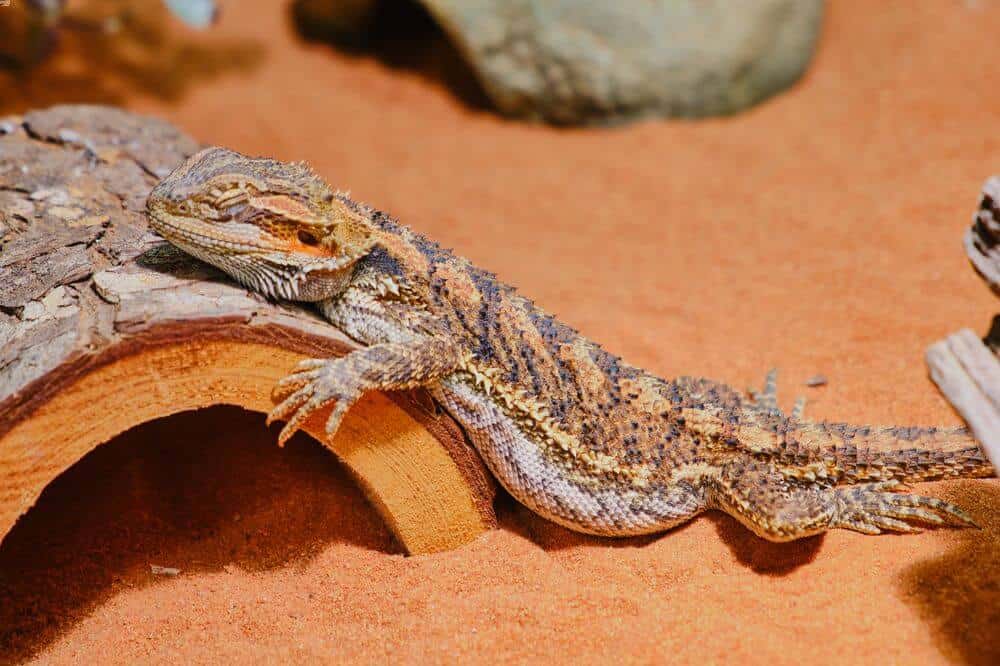
As we mentioned earlier, beardies are prone to ingesting loose-particle substrates. Despite its fine consistency, sand can be a major problem. It sticks to everything and can easily make its way onto food.
Not only does this cause potentially life-threatening impaction, but your bearded dragon could also harm its throat or teeth.
Don’t be fooled by products like calcium sand either. Calcium sand is advertised as a healthier alternative to traditional play sand or desert sand. Manufacturers will often say that it’s safe for your bearded dragon to ingest because it contains calcium, which is beneficial to reptiles.
You might even see some products touting additional “ingredients” like strontium, potassium, or magnesium. But it’s important to remember: You’re shopping for substrate, not supplements!
The truth is, calcium sand can cause just as much trouble as regular sand. It’s not going to magically disappear in your bearded dragon’s system. It can cause an impaction all the same.
Sand substrates can also irritate other parts of the body. All it takes is a quick run across the enclosure to kick up sand. It could get into your lizard’s eyes, sexual organs, or nostrils.
Another negative aspect of sand is its ability to hold onto moisture. Sure, this could be beneficial if you need help raising humidity levels in the enclosure. But what about all of the other liquids in your bearded dragon’s habitat? What about feces and urine?
Sand presents a huge problem in the hygiene department. First of all, it’s a pain to clean. Even if you sift out solid messes or clumps of sand soaked in urine, you’re bound to leave some flecks behind.
Your bearded dragon can easily make contact with the waste particles, which will lead to bacterial infections.
Not only that, but those flecks of waste can easily fall through the sand and collect at the bottom of the enclosure. This creates a breeding ground for bacteria and harmful pathogens. It doesn’t take much for bacteria, parasites, and viruses to take over.
All of a sudden, your bearded dragon’s habitat becomes a petri dish of disease!
Many think that sand is a suitable option because it mimics their natural environment. They think it’s similar to that of a litter box in terms of maintenance. But would you want to live in a litter box around the clock?
Expert Tip: You can add some sand to your bearded dragon’s enclosure for enrichment purposes. But it should always be contained in a digging box. Never use it for the substrate. Doing so is just asking for diseases and health problems.
Other Substrate Materials To Avoid
Sand isn’t the only thing you should avoid when picking out a substrate for bearded dragons. Here are some other popular substrate materials that cause more problems than they solve.
Gravel
Gravel is even worse than sand when it comes to ingestion. Gravel is small chunks of rock, which can look appetizing to a beardie.
Unfortunately, swallowing gravel can lead to choking. Even if your lizard manages to swallow it, the piece of gravel will almost always cause gut impaction.
Beyond those issues, gravel can also harbor bacteria and disease. It doesn’t soak up any liquid, but the gravel does have tiny nooks and crannies for messes to fall through. It’s very difficult to clean and just provides a place for disease to flourish.
Expert Tip: You can use gravel in small contained spaces where water flow is ideal. For example, it’s suitable for waterfalls. But you should never use it as a substrate.
Crushed Walnut
Crushed walnuts are another popular substrate you’ll see bagged up at the pet store.
But it’s nothing more than leftovers from a walnut processing plant. In other words, it contains sharp shells and dust.
The shells can be quite sharp, which is not great for bearded dragons. Your lizard could easily cut itself. Then, you’ll have to worry about infection.
Another problem is the walnut dust. It’s much finer than sand. Your reptile could breathe it in and experience irritation or respiratory infections.
It’s best to avoid walnut substrates. Also, steer clear of similar products like corn cob litter.
Wood Chips or Mulch
Like sand and other loose-particle substrates, wood chips will lead to impaction issues if ingested. This is sometimes used as bedding for other pet reptiles, but it’s not good for beardies.
It also holds onto moisture and creates a conducive environment for bacteria to thrive.
Another major problem with mulch and wood shavings is the oil they produce. Many natural wood species have oils and fumes that are toxic to bearded dragons. Pair that with all of the other risks and it’s better to just avoid it.
Potting Soil
Potting soil is just as bad as sand.
Many soil mixes are pretreated with fertilizers and other chemicals. They are designed to help plants flourish. However, those chemicals are not safe for reptiles.
Soil is also enriched with microorganisms that could cause harm to your beardie.
Millet
Millet is rarer than other substrates, but you can still find it in many pet stores. Basically, millet is a grain. Oftentimes, it’s processed to create loose-particle substrates.
Millet has all of the same issues as sand and wood chips. Your beardie could eat it and experience impaction.
Expert Tip: This substrate can also rot and produce mold!
Pellets
Whether the pellet is made of wood or alfalfa hay, don’t use it as a bearded dragon substrate. It’s a loose-particle material that your pet can easily eat.
Pellets are quite absorbent, too. Many experience mold and bacteria problems. Plus, the pellets can soften and create a disgusting mash.
Hay or Moss
Hay and moss are suitable for hiding boxes and small private areas. However, it’s not a good choice to cover the entire enclosure.
It can hold onto moisture and grow mold. Plus, hay is quite itchy. Individual hay strands are sharp enough to cause some discomfort for your beardie.
How To Properly Clean The Substrate
Even if you’re using one of the best substrates for bearded dragons, regular cleaning is a must! Your bearded dragon can’t live in its own filth. Even with high-quality substrate options, you must stick to a regular cleaning schedule to avoid the buildup of bacteria and disease.
If you’re using something like newspaper or paper towels, cleaning is as easy as tossing out soiled material and replacing it with something new. The same goes for loose-particle substrates if you choose to go that route.
But what if you’re using a more permanent substrate?
Well, the first step is to spot clean messes as soon as possible. This is especially important with reptile carpet. The longer you leave the mess to sit, the harder it’s going to be to clean.
Use a paper towel to blot liquid messes and pick up solid waste. For tiles, wipe messes down.
We also recommend using a disinfectant for spot cleaning. You can use a heavily diluted vinegar mixture or a reptile-safe sanitizer product. Just spray the spot and give it a good wipe. This will keep bacteria under control.
About once a month, you’ll need to do a deep clean. You should clean out the entire enclosure and all of its accessories. This includes the substrate.
To deep clean reptile carpet, soak it in hot water and scrub it clean! Use a large tub and some fragrance-free soap. Antibacterial products are a big plus!
Take your time to really scrub the carpet clean. You want to fully soak the material to remove any seeped-in mess.
While it’s tempting, don’t put the carpet into your washing machine. Bearded dragons can carry salmonella. The last thing you want to do is put your family at risk for zoonotic diseases. So, it’s best to clean the carpet in its own dedicated tub.
Expert Tip: Now, if you’re using tile, the deep cleaning process is going to be a bit different! Start by washing and disinfecting the tile like normal. Then, put it in the oven!
Bake the tile for 30 minutes to an hour at 250 degrees. The heat will kill any bacteria or pathogens. It’s an easy sanitization method that does the job. Make sure to let the tiles cool down completely before you put it back into the enclosure.
Closing Thoughts
You have a few options when it comes to picking the best substrate for bearded dragons. But as long as you stick with our recommendations, you can’t go wrong!
Remember, the right substrate can make a big impact on the overall healthy and comfort of your beardie. This is a decision that all great owners take seriously, and you should do the same.

